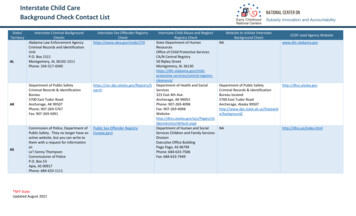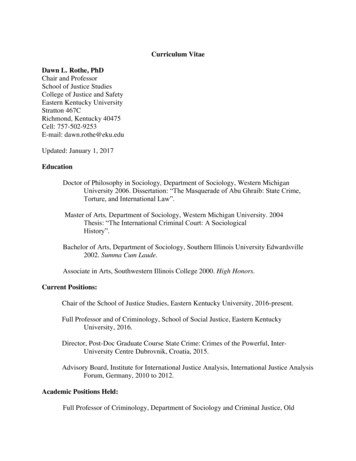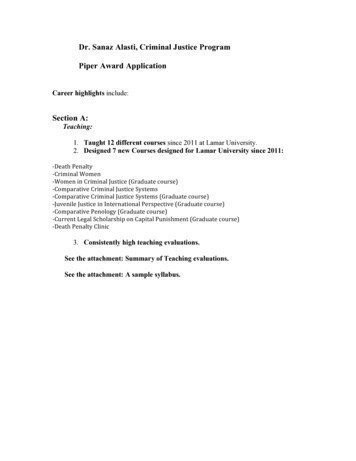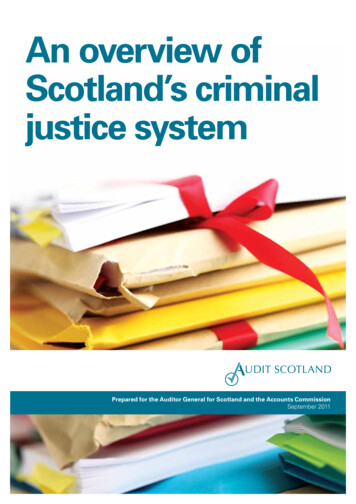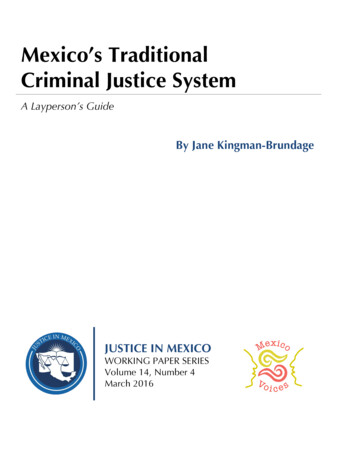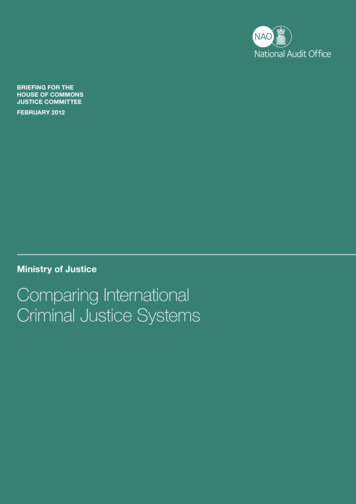
Transcription
PUBLIC LAW 105–251—OCT. 9, 1998INTERSTATE CRIMINAL JUSTICEIMPROVEMENTS
112 STAT. 1870PUBLIC LAW 105–251—OCT. 9, 1998Public Law 105–251105th CongressAn ActOct. 9, 1998[S. 2022]To provide for the improvement of interstate criminal justice identification, information, communications, and forensics.Be it enacted by the Senate and House of Representatives ofthe United States of America in Congress assembled,SECTION 1. TABLE OF CONTENTS.The table of contents for this Act is as follows:Sec. 1. Table of contents.TITLE I—CRIME IDENTIFICATION TECHNOLOGY ACT OF1998Sec. 101. Short title.Sec. 102. State grant program for criminal justice identification, information, andcommunication.TITLE II—NATIONAL CRIMINAL HISTORY ACCESS AND CHILDPROTECTION ACTSec. 201. Short title.Subtitle A—Exchange of Criminal History Records for Noncriminal Justice 4.215.216.217.Short title.Findings.Definitions.Enactment and consent of the United States.Effect on other laws.Enforcement and implementation.National Crime Prevention and Privacy Compact.OVERVIEWARTICLE I—DEFINITIONSARTICLE II—PURPOSESARTICLE III—RESPONSIBILITIES OF COMPACT PARTIESARTICLE IV—AUTHORIZED RECORD DISCLOSURESARTICLE V—RECORD REQUEST PROCEDURESARTICLE VI—ESTABLISHMENT OF COMPACT COUNCILARTICLE VII—RATIFICATION OF COMPACTARTICLE VIII—MISCELLANEOUS PROVISIONSARTICLE IX—RENUNCIATIONARTICLE X—SEVERABILITYARTICLE XI—ADJUDICATION OF DISPUTESSubtitle B—Volunteers for Children ActSec. 221. Short title.Sec. 222. Facilitation of fingerprint checks.
PUBLIC LAW 105–251—OCT. 9, 1998112 STAT. 1871TITLE I—CRIME IDENTIFICATIONTECHNOLOGY ACT OF 1998CrimeIdentificationTechnology Actof 1998.SEC. 101. SHORT TITLE.Records.This title may be cited as the ‘‘Crime Identification TechnologyAct of 1998’’.42 USC 14601note.SEC. 102. STATE GRANT PROGRAM FOR CRIMINAL JUSTICE IDENTIFICATION, INFORMATION, AND COMMUNICATION.42 USC 14601.(a) IN GENERAL.—Subject to the availability of amounts provided in advance in appropriations Acts, the Office of Justice Programs relying principally on the expertise of the Bureau of JusticeStatistics shall make a grant to each State, in a manner consistentwith the national criminal history improvement program, whichshall be used by the State, in conjunction with units of local government, State and local courts, other States, or combinations thereof,to establish or upgrade an integrated approach to develop information and identification technologies and systems to—(1) upgrade criminal history and criminal justice recordsystems, including systems operated by law enforcement agencies and courts;(2) improve criminal justice identification;(3) promote compatibility and integration of national, State,and local systems for—(A) criminal justice purposes;(B) firearms eligibility determinations;(C) identification of sexual offenders;(D) identification of domestic violence offenders; and(E) background checks for other authorized purposesunrelated to criminal justice; and(4) capture information for statistical and research purposes to improve the administration of criminal justice.(b) USE OF GRANT AMOUNTS.—Grants under this section maybe used for programs to establish, develop, update, or upgrade—(1) State centralized, automated, adult and juvenile criminal history record information systems, including arrest anddisposition reporting;(2) automated fingerprint identification systems that arecompatible with standards established by the National Instituteof Standards and Technology and interoperable with theIntegrated Automated Fingerprint Identification System(IAFIS) of the Federal Bureau of Investigation;(3) finger imaging, live scan, and other automated systemsto digitize fingerprints and to communicate prints in a mannerthat is compatible with standards established by the NationalInstitute of Standards and Technology and interoperable withsystems operated by States and by the Federal Bureau ofInvestigation;(4) programs and systems to facilitate full participationin the Interstate Identification Index of the National CrimeInformation Center;(5) systems to facilitate full participation in any compactrelating to the Interstate Identification Index of the NationalCrime Information Center;(6) systems to facilitate full participation in the nationalinstant criminal background check system established under
112 STAT. 1872PUBLIC LAW 105–251—OCT. 9, 1998section 103(b) of the Brady Handgun Violence Prevention Act(18 U.S.C. 922 note) for firearms eligibility determinations;(7) integrated criminal justice information systems to manage and communicate criminal justice information among lawenforcement agencies, courts, prosecutors, and corrections agencies;(8) noncriminal history record information systems relevantto firearms eligibility determinations for availability and accessibility to the national instant criminal background check system established under section 103(b) of the Brady HandgunViolence Prevention Act (18 U.S.C. 922 note);(9) court-based criminal justice information systems thatpromote—(A) reporting of dispositions to central State repositories and to the Federal Bureau of Investigation; and(B) compatibility with, and integration of, court systems with other criminal justice information systems;(10) ballistics identification and information programs thatare compatible and integrated with the National IntegratedBallistics Network (NIBN);(11) the capabilities of forensic science programs and medical examiner programs related to the administration of criminaljustice, including programs leading to accreditation or certification of individuals or departments, agencies, or laboratories,and programs relating to the identification and analysis ofdeoxyribonucleic acid;(12) sexual offender identification and registration systems;(13) domestic violence offender identification and information systems;(14) programs for fingerprint-supported background checkscapability for noncriminal justice purposes, including youthservice employees and volunteers and other individuals in positions of responsibility, if authorized by Federal or State lawand administered by a government agency;(15) criminal justice information systems with a capacityto provide statistical and research products including incidentbased reporting systems that are compatible with the NationalIncident-Based Reporting System (NIBRS) and uniform crimereports; and(16) multiagency, multijurisdictional communications systems among the States to share routine and emergency information among Federal, State, and local law enforcement agencies.(c) ASSURANCES.—(1) IN GENERAL.—To be eligible to receive a grant underthis section, a State shall provide assurances to the AttorneyGeneral that the State has the capability to contribute pertinentinformation to the national instant criminal background checksystem established under section 103(b) of the Brady HandgunViolence Prevention Act (18 U.S.C. 922 note).(2) INFORMATION SHARING.—Such assurances shall includea provision that ensures that a statewide strategy for information sharing systems is underway, or will be initiated, toimprove the functioning of the criminal justice system, withan emphasis on integration of all criminal justice components,law enforcement, courts, prosecution, corrections, and probationand parole. The strategy shall be prepared after consultation
PUBLIC LAW 105–251—OCT. 9, 1998112 STAT. 1873with State and local officials with emphasis on the recommendation of officials whose duty it is to oversee, plan, and implementintegrated information technology systems, and shall contain—(A) a definition and analysis of ‘‘integration’’ in theState and localities developing integrated information sharing systems;(B) an assessment of the criminal justice resourcesbeing devoted to information technology;(C) Federal, State, regional, and local information technology coordination requirements;(D) an assurance that the individuals who developedthe grant application took into consideration the needsof all branches of the State Government and specificallysought the advice of the chief of the highest court of theState with respect to the application;(E) State and local resource needs;(F) the establishment of statewide priorities for planning and implementation of information technology systems; and(G) a plan for coordinating the programs funded underthis title with other federally funded information technology programs, including directly funded local programssuch as the Local Law Enforcement Block Grant program(described under the heading ‘‘Violent Crime ReductionPrograms, State and Local Law Enforcement Assistance’’of the Departments of Commerce, Justice, and State, theJudiciary, and Related Agencies Appropriations Act, 1998(Public Law 105–119)) and the M.O.R.E. program established pursuant to part Q of title I of the Omnibus CrimeControl and Safe Streets Act of 1968.(d) MATCHING FUNDS.—The Federal share of a grant receivedunder this title may not exceed 90 percent of the costs of a programor proposal funded under this title unless the Attorney Generalwaives, wholly or in part, the requirements of this subsection.(e) AUTHORIZATION OF APPROPRIATIONS.—(1) IN GENERAL.—There is authorized to be appropriatedto carry out this section 250,000,000 for each of fiscal years1999 through 2003.(2) LIMITATIONS.—Of the amount made available to carryout this section in any fiscal year—(A) not more than 3 percent may be used by the Attorney General for salaries and administrative expenses;(B) not more than 5 percent may be used for technicalassistance, training and evaluations, and studies commissioned by Bureau of Justice Statistics of the Departmentof Justice (through discretionary grants or otherwise) infurtherance of the purposes of this section;(C) not less than 20 percent shall be used by theAttorney General for the purposes described in paragraph(11) of subsection (b); and(D) the Attorney General shall ensure the amountsare distributed on an equitable geographic basis.(f) GRANTS TO INDIAN TRIBES.—Notwithstanding any otherprovision of this section, the Attorney General may use amountsmade available under this section to make grants to Indian tribesfor use in accordance with this section.
112 STAT. 1874PUBLIC LAW 105–251—OCT. 9, 1998NationalCriminal HistoryAccess and ChildProtection Act.Records.TITLE II—NATIONAL CRIMINAL HISTORY ACCESS AND CHILD PROTECTION ACT42 USC 14601note.SEC. 201. SHORT TITLE.National CrimePrevention andPrivacy CompactAct of 1998.Records.42 USC 14601note.42 USC 14611.This title may be cited as the ‘‘National Criminal History Accessand Child Protection Act’’.Subtitle A—Exchange of Criminal HistoryRecords for Noncriminal Justice PurposesSEC. 211. SHORT TITLE.This subtitle may be cited as the ‘‘National Crime Preventionand Privacy Compact Act of 1998’’.SEC. 212. FINDINGS.Congress finds that—(1) both the Federal Bureau of Investigation and Statecriminal history record repositories maintain fingerprint-basedcriminal history records;(2) these criminal history records are shared and exchangedfor criminal justice purposes through a Federal-State programknown as the Interstate Identification Index System;(3) although these records are also exchanged for legallyauthorized, noncriminal justice uses, such as governmentallicensing and employment background checks, the purposesfor and procedures by which they are exchanged vary widelyfrom State to State;(4) an interstate and Federal-State compact is necessaryto facilitate authorized interstate criminal history recordexchanges for noncriminal justice purposes on a uniform basis,while permitting each State to effectuate its own disseminationpolicy within its own borders; and(5) such a compact will allow Federal and State recordsto be provided expeditiously to governmental and nongovernmental agencies that use such records in accordance with pertinent Federal and State law, while simultaneously enhancingthe accuracy of the records and safeguarding the informationcontained therein from unauthorized disclosure or use.42 USC 14612.SEC. 213. DEFINITIONS.In this subtitle:(1) ATTORNEY GENERAL.—The term ‘‘Attorney General’’means the Attorney General of the United States.(2) COMPACT.—The term ‘‘Compact’’ means the NationalCrime Prevention and Privacy Compact set forth in section217.(3) COUNCIL.—The term ‘‘Council’’ means the CompactCouncil established under Article VI of the Compact.(4) FBI.—The term ‘‘FBI’’ means the Federal Bureau ofInvestigation.(5) PARTY STATE.—The term ‘‘Party State’’ means a Statethat has ratified the Compact.
PUBLIC LAW 105–251—OCT. 9, 1998112 STAT. 1875(6) STATE.—The term ‘‘State’’ means any State, territory,or possession of the United States, the District of Columbia,and the Commonwealth of Puerto Rico.SEC. 214. ENACTMENT AND CONSENT OF THE UNITED STATES.42 USC 14613.The National Crime Prevention and Privacy Compact, as setforth in section 217, is enacted into law and entered into by theFederal Government. The consent of Congress is given to Statesto enter into the Compact.SEC. 215. EFFECT ON OTHER LAWS.42 USC 14614.(a) PRIVACY ACT OF 1974.—Nothing in the Compact shall affectthe obligations and responsibilities of the FBI under section 552aof title 5, United States Code (commonly known as the ‘‘PrivacyAct of 1974’’).(b) ACCESS TO CERTAIN RECORDS NOT AFFECTED.—Nothing inthe Compact shall interfere in any manner with—(1) access, direct or otherwise, to records pursuant to—(A) section 9101 of title 5, United States Code;(B) the National Child Protection Act;(C) the Brady Handgun Violence Prevention Act (PublicLaw 103–159; 107 Stat. 1536);(D) the Violent Crime Control and Law EnforcementAct of 1994 (Public Law 103–322; 108 Stat. 2074) or anyamendment made by that Act;(E) the United States Housing Act of 1937 (42 U.S.C.1437 et seq.); or(F) the Native American Housing Assistance and SelfDetermination Act of 1996 (25 U.S.C. 4101 et seq.); or(2) any direct access to Federal criminal history recordsauthorized by law.(c) AUTHORITY OF FBI UNDER DEPARTMENTS OF STATE, JUSTICE,AND COMMERCE, THE JUDICIARY, AND RELATED AGENCIES APPROPRIATION ACT, 1973.—Nothing in the Compact shall be construedto affect the authority of the FBI under the Departments of State,Justice, and Commerce, the Judiciary, and Related Agencies Appropriation Act, 1973 (Public Law 92–544 (86 Stat. 1115)).(d) FEDERAL ADVISORY COMMITTEE ACT.—The Council shallnot be considered to be a Federal advisory committee for purposesof the Federal Advisory Committee Act (5 U.S.C. App.).(e) MEMBERS OF COUNCIL NOT FEDERAL OFFICERS OR EMPLOYEES.—Members of the Council (other than a member from theFBI or any at-large member who may be a Federal official oremployee) shall not, by virtue of such membership, be deemed—(1) to be, for any purpose other than to effect the Compact,officers or employees of the United States (as defined in sections2104 and 2105 of title 5, United States Code); or(2) to become entitled by reason of Council membershipto any compensation or benefit payable or made available bythe Federal Government to its officers or employees.SEC. 216. ENFORCEMENT AND IMPLEMENTATION.All departments, agencies, officers, and employees of the UnitedStates shall enforce the Compact and cooperate with one anotherand with all Party States in enforcing the Compact and effectuatingits purposes. For the Federal Government, the Attorney Generalshall make such rules, prescribe such instructions, and take such42 USC 14615.
112 STAT. 1876PUBLIC LAW 105–251—OCT. 9, 1998other actions as may be necessary to carry out the Compact andthis subtitle.42 USC 14616.SEC. 217. NATIONAL CRIME PREVENTION AND PRIVACY COMPACT.The Contracting Parties agree to the following:OVERVIEW(a) IN GENERAL.—This Compact organizes an electronicinformation sharing system among the Federal Government andthe States to exchange criminal history records for noncriminaljustice purposes authorized by Federal or State law, such as background checks for governmental licensing and employment.(b) OBLIGATIONS OF PARTIES.—Under this Compact, the FBIand the Party States agree to maintain detailed databases of theirrespective criminal history records, including arrests and dispositions, and to make them available to the Federal Governmentand to Party States for authorized purposes. The FBI shall alsomanage the Federal data facilities that provide a significant partof the infrastructure for the system.ARTICLE I—DEFINITIONSIn this Compact:(1) ATTORNEY GENERAL.—The term ‘‘Attorney General’’means the Attorney General of the United States.(2) COMPACT OFFICER.—The term ‘‘Compact officer’’means—(A) with respect to the Federal Government, an officialso designated by the Director of the FBI; and(B) with respect to a Party State, the chief administrator of the State’s criminal history record repository ora designee of the chief administrator who is a regularfull-time employee of the repository.(3) COUNCIL.—The term ‘‘Council’’ means the CompactCouncil established under Article VI.(4) CRIMINAL HISTORY RECORDS.—The term ‘‘criminal history records’’—(A) means information collected by criminal justiceagencies on individuals consisting of identifiable descriptions and notations of arrests, detentions, indictments, orother formal criminal charges, and any disposition arisingtherefrom, including acquittal, sentencing, correctionalsupervision, or release; and(B) does not include identification information suchas fingerprint records if such information does not indicateinvolvement of the individual with the criminal justicesystem.(5) CRIMINAL HISTORY RECORD REPOSITORY.—The term‘‘criminal history record repository’’ means the State agencydesignated by the Governor or other appropriate executive official or the legislature of a State to perform centralized recordkeeping functions for criminal history records and services inthe State.(6) CRIMINAL JUSTICE.—The term ‘‘criminal justice’’ includesactivities relating to the detection, apprehension, detention,pretrial release, post-trial release, prosecution, adjudication,correctional supervision, or rehabilitation of accused persons
PUBLIC LAW 105–251—OCT. 9, 1998112 STAT. 1877or criminal offenders. The administration of criminal justiceincludes criminal identification activities and the collection,storage, and dissemination of criminal history records.(7) CRIMINAL JUSTICE AGENCY.—The term ‘‘criminal justiceagency’’—(A) means—(i) courts; and(ii) a governmental agency or any subunit thereofthat—(I) performs the administration of criminal justice pursuant to a statute or Executive order; and(II) allocates a substantial part of its annualbudget to the administration of criminal justice;and(B) includes Federal and State inspectors generaloffices.(8) CRIMINAL JUSTICE SERVICES.—The term ‘‘criminal justiceservices’’ means services provided by the FBI to criminal justiceagencies in response to a request for information about aparticular individual or as an update to information previouslyprovided for criminal justice purposes.(9) CRITERION OFFENSE.—The term ‘‘criterion offense’’means any felony or misdemeanor offense not included on thelist of nonserious offenses published periodically by the FBI.(10) DIRECT ACCESS.—The term ‘‘direct access’’ meansaccess to the National Identification Index by computer terminal or other automated means not requiring the assistanceof or intervention by any other party or agency.(11) EXECUTIVE ORDER.—The term ‘‘Executive order’’ meansan order of the President of the United States or the chiefexecutive officer of a State that has the force of law andthat is promulgated in accordance with applicable law.(12) FBI.—The term ‘‘FBI’’ means the Federal Bureau ofInvestigation.(13) INTERSTATE IDENTIFICATION SYSTEM.—The term ‘‘Interstate Identification Index System’’ or ‘‘III System’’—(A) means the cooperative Federal-State system forthe exchange of criminal history records; and(B) includes the National Identification Index, theNational Fingerprint File and, to the extent of their participation in such system, the criminal history record repositories of the States and the FBI.(14) NATIONAL FINGERPRINT FILE.—The term ‘‘NationalFingerprint File’’ means a database of fingerprints, or otheruniquely personal identifying information, relating to anarrested or charged individual maintained by the FBI to providepositive identification of record subjects indexed in the III System.(15) NATIONAL IDENTIFICATION INDEX.—The term ‘‘NationalIdentification Index’’ means an index maintained by the FBIconsisting of names, identifying numbers, and other descriptiveinformation relating to record subjects about whom there arecriminal history records in the III System.(16) NATIONAL INDICES.—The term ‘‘National indices’’means the National Identification Index and the NationalFingerprint File.
112 STAT. 1878PUBLIC LAW 105–251—OCT. 9, 1998(17) NONPARTY STATE.—The term ‘‘Nonparty State’’ meansa State that has not ratified this Compact.(18) NONCRIMINAL JUSTICE PURPOSES.—The term ‘‘noncriminal justice purposes’’ means uses of criminal historyrecords for purposes authorized by Federal or State law otherthan purposes relating to criminal justice activities, includingemployment suitability, licensing determinations, immigrationand naturalization matters, and national security clearances.(19) PARTY STATE.—The term ‘‘Party State’’ means a Statethat has ratified this Compact.(20) POSITIVE IDENTIFICATION.—The term ‘‘positive identification’’ means a determination, based upon a comparison offingerprints or other equally reliable biometric identificationtechniques, that the subject of a record search is the sameperson as the subject of a criminal history record or recordsindexed in the III System. Identifications based solely upona comparison of subjects’ names or other nonunique identification characteristics or numbers, or combinations thereof, shallnot constitute positive identification.(21) SEALED RECORD INFORMATION.—The term ‘‘sealedrecord information’’ means—(A) with respect to adults, that portion of a recordthat is—(i) not available for criminal justice uses;(ii) not supported by fingerprints or other acceptedmeans of positive identification; or(iii) subject to restrictions on dissemination fornoncriminal justice purposes pursuant to a court orderrelated to a particular subject or pursuant to a Federalor State statute that requires action on a sealing petition filed by a particular record subject; and(B) with respect to juveniles, whatever each Statedetermines is a sealed record under its own law and procedure.(22) STATE.—The term ‘‘State’’ means any State, territory,or possession of the United States, the District of Columbia,and the Commonwealth of Puerto Rico.ARTICLE II—PURPOSESThe purposes of this Compact are to—(1) provide a legal framework for the establishment ofa cooperative Federal-State system for the interstate and Federal-State exchange of criminal history records for noncriminaljustice uses;(2) require the FBI to permit use of the National Identification Index and the National Fingerprint File by each PartyState, and to provide, in a timely fashion, Federal and Statecriminal history records to requesting States, in accordancewith the terms of this Compact and with rules, procedures,and standards established by the Council under Article VI;(3) require Party States to provide information and recordsfor the National Identification Index and the National Fingerprint File and to provide criminal history records, in a timelyfashion, to criminal history record repositories of other Statesand the Federal Government for noncriminal justice purposes,in accordance with the terms of this Compact and with rules,
PUBLIC LAW 105–251—OCT. 9, 1998112 STAT. 1879procedures, and standards established by the Council underArticle VI;(4) provide for the establishment of a Council to monitorIII System operations and to prescribe system rules and procedures for the effective and proper operation of the III Systemfor noncriminal justice purposes; and(5) require the FBI and each Party State to adhere toIII System standards concerning record dissemination and use,response times, system security, data quality, and other dulyestablished standards, including those that enhance theaccuracy and privacy of such records.ARTICLE III—RESPONSIBILITIES OF COMPACT PARTIES(a) FBI RESPONSIBILITIES.—The Director of the FBI shall—(1) appoint an FBI Compact officer who shall—(A) administer this Compact within the Departmentof Justice and among Federal agencies and other agenciesand organizations that submit search requests to the FBIpursuant to Article V(c);(B) ensure that Compact provisions and rules, procedures, and standards prescribed by the Council under Article VI are complied with by the Department of Justiceand the Federal agencies and other agencies and organizations referred to in Article III(1)(A); and(C) regulate the use of records received by means ofthe III System from Party States when such records aresupplied by the FBI directly to other Federal agencies;(2) provide to Federal agencies and to State criminal historyrecord repositories, criminal history records maintained in itsdatabase for the noncriminal justice purposes described in Article IV, including—(A) information from Nonparty States; and(B) information from Party States that is availablefrom the FBI through the III System, but is not availablefrom the Party State through the III System;(3) provide a telecommunications network and maintaincentralized facilities for the exchange of criminal history recordsfor both criminal justice purposes and the noncriminal justicepurposes described in Article IV, and ensure that the exchangeof such records for criminal justice purposes has priority overexchange for noncriminal justice purposes; and(4) modify or enter into user agreements with NonpartyState criminal history record repositories to require them toestablish record request procedures conforming to those prescribed in Article V.(b) STATE RESPONSIBILITIES.—Each Party State shall—(1) appoint a Compact officer who shall—(A) administer this Compact within that State;(B) ensure that Compact provisions and rules, procedures, and standards established by the Council underArticle VI are complied with in the State; and(C) regulate the in-State use of records received bymeans of the III System from the FBI or from other PartyStates;(2) establish and maintain a criminal history record repository, which shall provide—
112 STAT. 1880PUBLIC LAW 105–251—OCT. 9, 1998(A) information and records for the National Identification Index and the National Fingerprint File; and(B) the State’s III System-indexed criminal historyrecords for noncriminal justice purposes described in ArticleIV;(3) participate in the National Fingerprint File; and(4) provide and maintain telecommunications links andrelated equipment necessary to support the services set forthin this Compact.(c) COMPLIANCE WITH III SYSTEM STANDARDS.—In carrying outtheir responsibilities under this Compact, the FBI and each PartyState shall comply with III System rules, procedures, and standardsduly established by the Council concerning record disseminationand use, response times, data quality, system security, accuracy,privacy protection, and other aspects of III System operation.(d) MAINTENANCE OF RECORD SERVICES.—(1) Use of the III System for noncriminal justice purposesauthorized in this Compact shall be managed so as not todiminish the level of services provided in support of criminaljustice purposes.(2) Administration of Compact provisions shall not reducethe level of service available to authorized noncriminal justiceusers on the effective date of this Compact.ARTICLE IV—AUTHORIZED RECORD DISCLOSURES(a) STATE CRIMINAL HISTORY RECORD REPOSITORIES.—To theextent authorized by section 552a of title 5, United States Code(commonly known as the ‘‘Privacy Act of 1974’’), the FBI shallprovide on request criminal history records (excluding sealedrecords) to State criminal history record repositories for noncriminaljustice purposes allowed by Federal statute, Federal Executiveorder, or a State statute that has been approved by the AttorneyGeneral and that authorizes national indices checks.(b) CRIMINAL JUSTICE AGENCIES AND OTHER GOVERNMENTALOR NONGOVERNMENTAL AGENCIES.—The FBI, to the extent authorized by section 552a of title 5, United States Code (commonlyknown as the ‘‘Privacy Act of 1974’’), and State criminal historyrecord repositories shall provide criminal history records (excludingsealed records) to criminal justice agencies and other governmentalor nongovernmental agencies for noncriminal justice purposesallowed by Federal statute, Federal Executive order, or a Statestatute that has been approved by the Attorney General, thatauthorizes national indices checks.(c) PROCEDURES.—Any record obtained under this Compact maybe used only for the official purposes for which the record wasrequested. Each Compact officer shall establish procedures, consistent with this Compact, and with rules, procedures, and standardsestablished by the Council under Article VI, which procedures shallprotect the accuracy and privacy of the records, and shall—(1) ensure that records obtained under this Compact areused only by authorized officials for authorized purposes;(2) require that subsequent record checks are requestedto obtain current information whenever a new need arises;and(3) ensure that record entries that may not legally beused for a particular noncriminal justice purpose are deleted
PUBLIC LAW 105–251—OCT. 9, 1998112 STAT. 1881from the response and, if no information authorized for releaseremains, an appropriate ‘‘no record’’ response is communicatedto the requesting official.ARTICLE V—RECORD REQUEST PROCEDURES(a) POSITIVE IDENTIFICATION.—Subject fingerprints or otherapproved forms of positive identification shall be submitted withall requests for criminal history record c
tems among the States to share routine and emergency informa-tion among Federal, State, and local law enforcement agencies. (c) ASSURANCES.— (1) IN GENERAL.—To be eligible to receive a grant under this section, a State shall provide assurances to the Attorney General that the State has the capability to contribute pertinent

